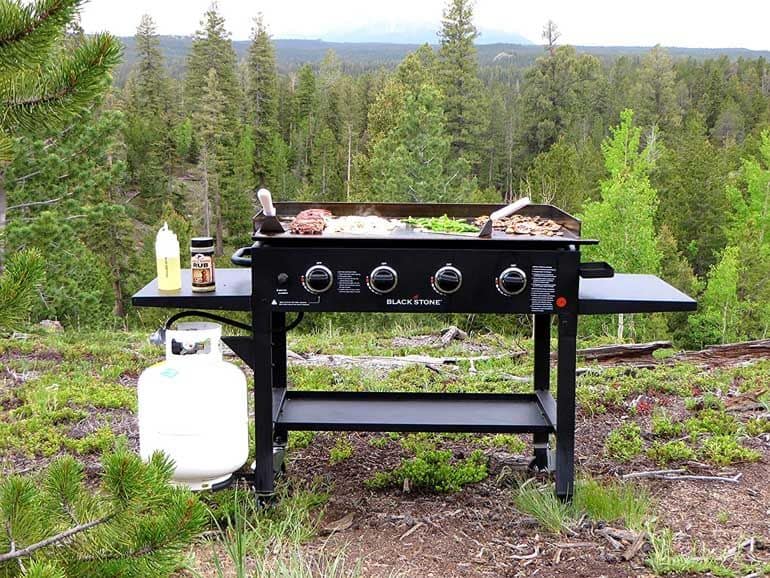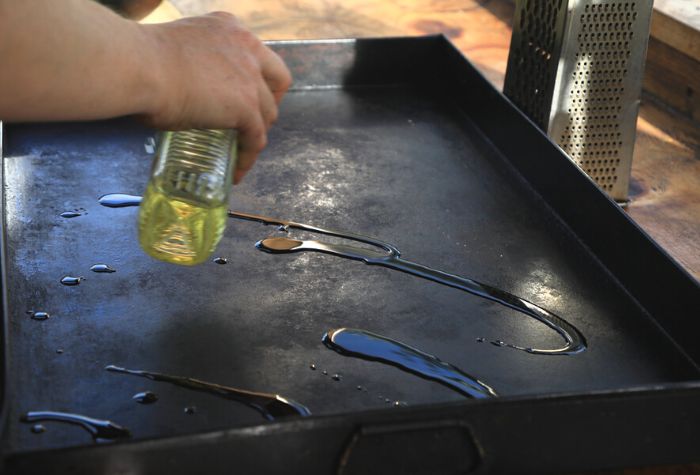Take your griddle-cooked food to the next level with the best oil for your Blackstone or flat top. From high smoke points to heart-healthy fats, these are the best oils for griddle cooking.
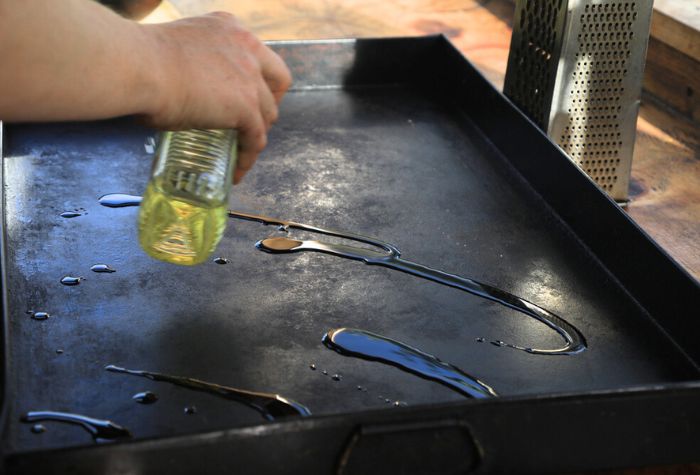
If there’s one thing that’s always overlooked when griddle cooking, it’s choosing the right cooking oil.
Getting your choice of griddle cooking oil right can make or break your outdoor cooking. As well as performing the basic function of keeping food from sticking to your cooking surface, a good oil can help make your griddle more heat-efficient and enhance the flavor of your food.
You also need to choose an oil that can withstand the high heat of griddle cooking with a high smoke point, not to mention the health implications of choosing an oil low in saturated fats.
Don’t let your oil choice be an afterthought. From canola to grapeseed, these are the best oils for griddle cooking to try today.
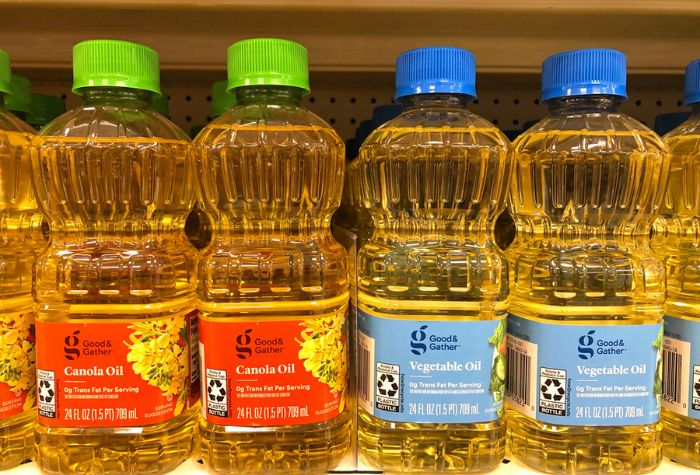
Avocado Oil
With a high smoking point of 520 °F (270°C), avocado oil is one of the best oils for cooking at high temperatures. It contains unsaturated fats and heart-healthy acids, such as oleic acid. It only gives a mild taste, meaning that your griddle-cooked food won’t be overshadowed by the oil.
The high smoke point allows for different types of cooking on the griddle safely. Whether searing or sauteing, avocado oil will be an excellent option.
Avocado oil has a relatively neutral flavor compared to its counterparts, which makes it a convenient option for different food categories. Except for a subtle hint of avocado flavor, you shouldn’t expect much when cooking with avocado oil.
Health freaks love avocado oil because it goes through minimal processing and provides a handful of health benefits. It’s high in antioxidants, monounsaturated fats (oleic acid specifically), and fibers, which contributes to heart health.
Canola Oil
Canola oil is a type of vegetable oil with a neutral taste and a relatively high smoke point at 400 °F (205°C) for refined and 375 – 450 °F (190-230°C) for expeller pressed.
The smoke point of canola oil varies depending on its type and manufacturer, so you’ve got to be careful when buying it.
Canola oil has a low percentage of saturated fats. It’s also good for your heart health, as it lowers the risk of coronary disease. In addition, canola oil is rich in omega-3 fats that help lower the levels of bad cholesterol.
Olive Oil
When it comes to griddle cooking, olive oil has an average smoke point of 425 °F (220°C), making it a nice option for most foods. Given its peppery flavor, olive oil goes well with meat. It’ll add depth and flavor to whatever you’re cooking.
Extra virgin olive oil undergoes less processing, however it has a lower smoke point of around 400°F (205°C).
Another appeal of olive oil is its health benefits, as it’s packed with amino acids, monounsaturated fats, and polyphenols. Extra virgin olive oil is also rich in vitamins E and K.
Sunflower Seed Oil
Sunflower seed oil comes with a strong 440 °F (225°C) smoke point and unobtrusive flavor that renders it perfect for griddle cooking. The only downside to sunflower oil is that it’s a bit on the pricier side.
Sunflower seed oil lies on the good side of cooking oils when it comes to its health benefits. It has a low percentage of saturated fats, which helps lower the levels of LDL cholesterol.
Vegetable Oil
Made from a blend of oils, vegetable oil is super versatile because of its neutral taste and high smoke point (428 – 450 °F). These reasons also make it a suitable oil for griddle cooking, where it’s mostly used to season griddles.
Peanut Oil
Peanut oil is one of the oils that’s slept on when it comes to griddle cooking. It’s not that common in the US, but it’s a staple in Asian cuisine.
With a smoking point of 450 °F (230°C), you can see why peanut oil is an excellent option for griddle cooking. You can expect peanut oil to have a strong flavor, and you’re right. You’ll notice a significant nutty flavor when using it.
Peanut oil has a high percentage of monounsaturated fats and a low percentage of saturated fats, which helps lower the fatty buildup in blood vessels.
Similar to avocado oil, peanut oil is on the pricier side of cooking oils.
Grapeseed Oil
Another viable option for griddle cooking is grapeseed oil. This oil is high in fatty acids and has a relatively high smoke point of 390 °F (200°C).
Grapeseed oil comes from grapes that are discarded from the wine-making process. Its flavor and odor are mild, so it’s a good option if you don’t need a ‘seasoning’ oil.
Don’t be generous when applying grapeseed oil to your griddle surface. Apart from being expensive, it’s greasy and it darkens the surface of the griddle easily. A little bit goes a long way.
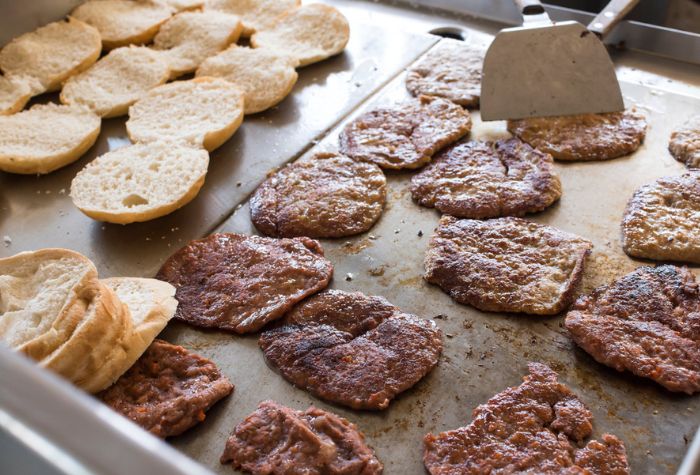
Why Should You Oil Your Griddle?
You can’t cook food on a griddle without oil. Not only does oil prevent food from sticking to the griddle, but it also adds flavor to your food. Whether it’s burgers, ribs, or grilled chicken sandwiches, oiling the griddle makes a big difference.
Besides, it makes the cleaning process easier.
You’ll need oil to flavor food, and you’ll need it to season the griddle itself so that food doesn’t stick to the griddle cooktop.
Ask any master chef and they’ll tell you that the benefits of a griddle oil coat go beyond the stickiness dilemma; the oil helps transport heat to the food itself during the cooking process.
If you’d like to add a specific flavor, you can use an oil with a distinct flavor. Olive oil blends are big in this category.
What Should You Look For in Griddle Oil?
If you’re still confused, here are the factors that’ll help you decide which oil works best for you.
Smoke Point
Cooking on a griddle requires high temperatures, especially when you’re cooking meat. For this reason, you need to choose an oil with a high smoke point to withstand heat.
An oil’s smoke point, or burning point, is the point at which it stops shimmering and starts to smoke. Smoke points range vary between 325 – 520 °F (160 – 270 °C).
While oil smoking might be inevitable in some situations as deep frying, you want to avoid it as much as possible. This is because when the oil reaches its smoke point, its bonds start to break, producing free radicals that are harmful to our health. Also, at the smoke point, oils produce chemicals that affect the food’s taste.
That’s why it’s essential to choose an oil with a smoke point suitable to your cooking method, specifically the amount of heat your cooking method requires. Think sautéing vs. searing, for example.
When it comes to griddle cooking, we recommend you use an oil with a smoke point of 400 °F (205°C) or higher. It’d be a clever idea to get an infrared thermometer for the griddle to measure the temperature accurately to avoid burning oils.
Monounsaturated Fats
Monosaturated fats (Oleic acid, Omega-9) are ‘good’ fats that help regulate the body’s cholesterol levels, lowering bad cholesterol in particular, which results in better cardiac health.
They’re found in canola oil, olive oil, peanut oil, and sesame oil.
Polyunsaturated Fats
The famous Omega-3 and Omega-6 are polyunsaturated fats, which help your body absorb fat-soluble vitamins like A, D, and E.
Vegetable oil is rich in polyunsaturated fats.
Flavor
This one is subjective. How much do you want the seasoning oil to contribute to the taste of your griddle-cooked food?
The answer might vary between “I want the oil to have a powerful flavor” to “I just don’t want food to stick to the griddle!”
It’s a personal preference but also varies according to what you’re cooking. For example, if you’re cooking beef, you’ll probably want something to affect the taste. On the other side, you wouldn’t want that when cooking a bacon and eggs breakfast.
Most of the oils mentioned in the article are neutrally flavored. Peanut oil and olive oil are the ones that have noticeable nutty and peppery flavors, respectively.


